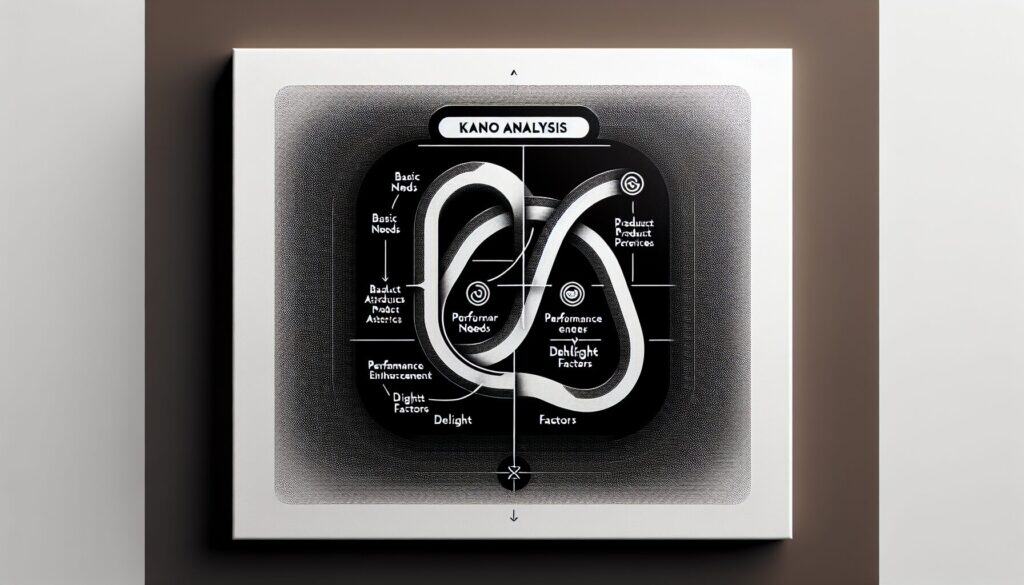Um Kundenpräferenzen hinsichtlich Produktmerkmalen zu ermitteln und zu kategorisieren und zwischen jenen zu unterscheiden, die Grundbedürfnisse befriedigen, die Leistung steigern oder Kunden begeistern.
- Methodologien: Kunden & Marketing, Ideenfindung, Produktdesign
Kano-Analyse (Kano-Modell)

Kano-Analyse (Kano-Modell)
- Kundenerfahrung, Customer Journey Mapping, Design Denken, Innovation, Produktentwicklung, Produktmanagement, Einsatz von Qualitätsfunktionen (QFD), Benutzererfahrung (UX), Wert-Angebot
Zielsetzung:
Wie es verwendet wird:
- Die Kunden werden anhand eines spezifischen Fragenpaars (funktionale und dysfunktionale Formen) für jede Funktion befragt. Die Antworten werden dann den Kategorien „Muss sein“, „Leistung“, „Attraktiv (Begeisternd)“, „Gleichgültig“ und „Umgekehrte Qualitäten“ zugeordnet.
Vorteile
- Hilft, die Funktionsentwicklung auf der Grundlage der Kundenauswirkungen zu priorisieren, identifiziert unausgesprochene Kundenbedürfnisse (Delighter), vermeidet Überinvestitionen in Funktionen mit geringer Auswirkung und bietet einen Rahmen zum Verständnis der Kundenzufriedenheitsdynamik.
Nachteile
- Erfordert eine sorgfältige Gestaltung und Durchführung der Umfrage, die Datenanalyse kann komplex sein, Kundenpräferenzen können sich im Laufe der Zeit ändern, die Interpretation der Ergebnisse erfordert einen Kontext und kann subjektiv sein.
Kategorien:
- Kunden & Marketing, Ideenfindung, Produktdesign, Qualität
Am besten geeignet für:
- Priorisieren Sie Produktfunktionen, verstehen Sie die Erwartungen der Kunden und erkennen Sie Innovationsmöglichkeiten, indem Sie sich auf Eigenschaften konzentrieren, die die Zufriedenheit und Begeisterung der Kunden steigern.
Die Kano-Analyse ist besonders in den frühen Phasen der Produktentwicklung von Vorteil, wo das Verständnis der Kundenpräferenzen die Designentscheidungen und die Ressourcenzuweisung erheblich beeinflussen kann. Branchen wie die Technologie-, Automobil-, Unterhaltungselektronik- und Gesundheitsbranche wenden diese Methode häufig an, um zu ermitteln, wie verschiedene Funktionen mit den Erwartungen der Benutzer übereinstimmen. In der Regel sind funktionsübergreifende Teams beteiligt, darunter Designer, Ingenieure, Marketingspezialisten und Kundendienstmitarbeiter, die zusammenarbeiten, um Kundenfeedback zu sammeln und zu interpretieren. Die aus dem Kano-Modell gewonnenen Erkenntnisse ermöglichen es den Teams, zu erkennen, welche Funktionen standardmäßig unerlässlich sind, wie z. B. die Batterielebensdauer bei elektronischen Geräten, die erfüllt werden müssen, um Unzufriedenheit zu vermeiden, und welche Funktionen die Benutzer begeistern können, wie z. B. innovative Benutzeroberflächen oder einzigartige ästhetische Oberflächen, die die grundlegenden Erwartungen übertreffen. Diese proaktive Herangehensweise kann zu strategischen Innovationen führen, die ursprünglich vielleicht nicht in Betracht gezogen wurden, da sie latente Kundenwünsche aufdeckt, die ein Produkt von der Konkurrenz abheben können. Darüber hinaus können Unternehmen eine Fehlallokation von Ressourcen vermeiden, indem sie Merkmale erkennen, die als gleichgültige oder umgekehrte Qualitäten eingestuft werden, und so sicherstellen, dass die Investitionen in die Produktentwicklung auf Attribute konzentriert werden, die die Benutzerzufriedenheit wirklich erhöhen. Bei der Durchführung von Untersuchungen können Methoden wie Umfragen effektiv eingesetzt werden, um Kundenantworten zu segmentieren und detaillierte Erkenntnisse zu gewinnen, die die Grundlage für iterative Produktverbesserungen bilden.
Die wichtigsten Schritte dieser Methodik
- Erstellen Sie eine Liste von Produktmerkmalen oder -eigenschaften für die Bewertung.
- Formulieren Sie Fragenpaare für jedes Merkmal, sowohl in funktionaler als auch in dysfunktionaler Form.
- Verteilen Sie die Umfrage an die Kunden und sammeln Sie deren Antworten.
- Analysieren Sie die Kundenreaktionen, indem Sie sie den Kano-Kategorien zuordnen: Muss, Leistung, Attraktiv, Indifferent und Umgekehrt.
- Setzen Sie Prioritäten bei den Funktionen auf der Grundlage ihrer Kategorisierung und der Auswirkungen auf die Kunden.
- Identifizierung von Innovations- und Verbesserungsmöglichkeiten durch die Analyse von Begeisterten.
- Überprüfung und Anpassung der Produktentwicklungsstrategien auf der Grundlage der Ergebnisse des Kano-Modells.
Profi-Tipps
- Die Einbeziehung qualitativer Daten aus Kundenbefragungen bereichert die quantitativen Umfrageergebnisse und offenbart die tieferen Beweggründe für die Präferenzen.
- Regelmäßige Anpassung der Kano-Analyse an die sich ändernde Marktdynamik, um sicherzustellen, dass sie mit den sich ändernden Kundenerwartungen und Wettbewerbstrends übereinstimmt.
- Nutzen Sie die funktionsübergreifende Zusammenarbeit bei der Interpretation der Kano-Ergebnisse, um verschiedene Perspektiven zu integrieren und innovative Lösungen zu finden, die bei den Nutzern ankommen.
Verschiedene Methoden lesen und vergleichen, Wir empfehlen die
> Umfassendes Methoden-Repository <
zusammen mit den über 400 anderen Methoden.
Ihre Kommentare zu dieser Methodik oder zusätzliche Informationen sind willkommen auf der Kommentarbereich unten ↓ , sowie alle ingenieursbezogenen Ideen oder Links.
Historischer Kontext
1960
1980
1983
1990
1995
2000
2010
1950
1980
1980
1986
1994
1995
2000
(wenn das Datum nicht bekannt oder nicht relevant ist, z. B. "Strömungsmechanik", wird eine gerundete Schätzung des bemerkenswerten Erscheinens angegeben)














Verwandte Artikel
Monte-Carlo-Simulation
Modellbasiertes Testen
Modellprüfung
Forschung mit gemischten Methoden
Fehlervermeidung (Poka-Yoke)
Prüfung des Missionsprofils